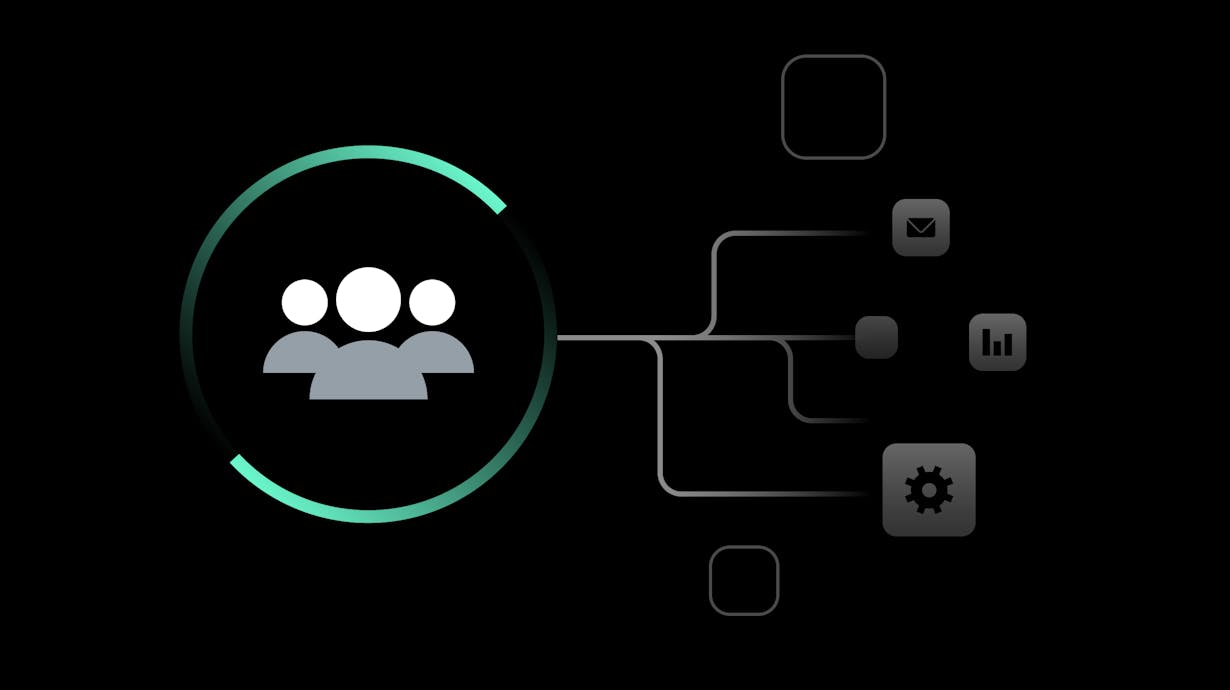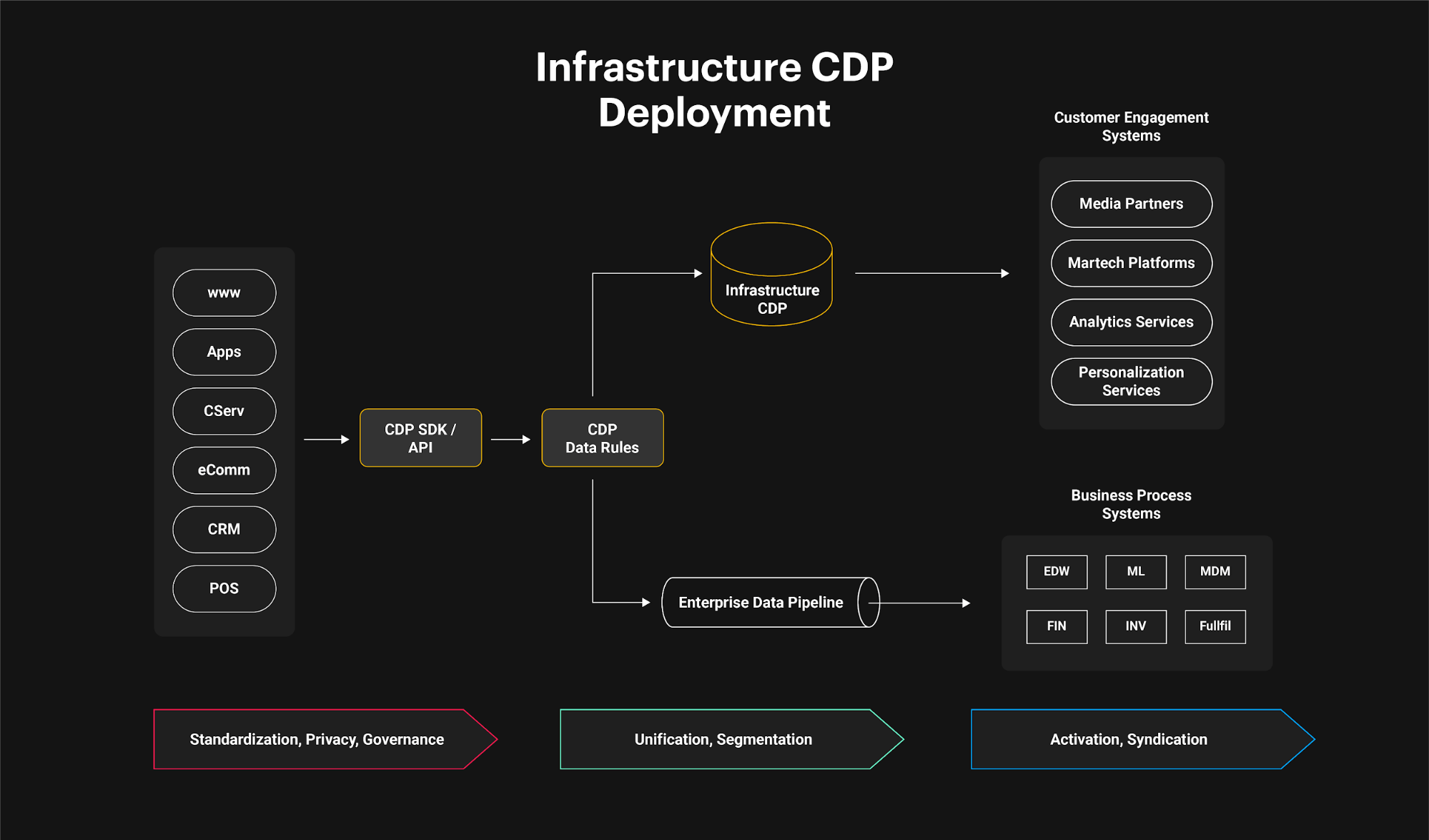Where should you be building your audience segments?
Every tool seems to offer segmentation capabilities these days. Disconnected audiences builders, however, can lead to overreliance on developer support and disjointed customer experiences. Learn more about data infrastructure and when it helps to centralize your audience segmentation.

If you take an audit of your tech stack, chances are you’ll come across quite a few audience builders throughout the tools and systems you use to drive growth. Some may be designed to query historical records, others built to power real-time transactional emails or A/B tests.
While it’s certainly necessary to have a segmentation engine in each tool that requires one to function, siloed audience builders can make it very difficult to sync segments across systems–a task that’s becoming increasingly important as growth teams aim to orchestrate experiences that are connected across channels. When two downstream systems don’t have an easy way to share audiences with each other, business teams are forced to request developer assistance for .csv transfers, data transformations, and other tedious tasks to accomplish customer-facing initiatives. Such maintenance jobs pull developers away from core work, delay marketing and product teams from launching, and can lead to negative experiences for the end customer.
Until recently, however, growth teams and developers had few alternatives. Integration Platform as a Service (iPaaS) solutions and webhooks could be implemented to forward events between tools, but they weren't robust enough to connect audience segments between systems in real-time.
Today, infrastructural Customer Data Platforms with audience segmentation capabilities provide an opportunity to move audience building earlier in your data pipeline and improve the interoperability of each audience created.
What’s a Customer Data Platform?
While the category was originally formed around 2013, the Customer Data Platform space first began to generate awareness around 2017. At that time, many adjacent solutions, such as tag managers, analytics tools, and marketing automation platforms, began to brand themselves as CDPs, resulting in a cluttered market.
A Customer Data Platform is a centralized data infrastructure that aims to aggregate and make sense of a company’s customer data.
There are five key functions of a CDP:
- Data collection: The ability to ingest first-party, individual-level customer data from multiple sources via packaged API connections and SDKs, and store that data in a usable format
- Data governance: The ability to granularly enforce which events gets passed onto each system, and process data subject requests - access, portability, erasure
- Data quality protection and profile unification: The ability to monitor data accuracy, consistency, deduplication, and structure, and to unify events and attributes to persistent profiles at the individual-level as data is collected
- Segmentation: An interface that enables business users to build and manage audience segments
- Activation: The ability to send audience segments and forward events to external tools and systems through pre-built integrations, as well as to orchestrate contextual marketing experiences across channels
It’s worth noting that not all CDP vendors accomplish each of these functions to the same extent, and therefore the ways in which teams adopt CDPs is still varied.
What’s an Infrastructure CDP?
As an emerging category in a complex ecosystem, the ways in which teams adopt CDPs is still varied and nuanced. That being said, there are 2 main types of CDP deployments: Infrastructure CDPs and Application CDPs. While they both share many overlapping capabilities - identity resolution, holistic customer view, API integrations - the deployment choice between the two is significant.
Infrastructure CDP’s are more foundational and must provide a different set of capabilities than their counterparts. They are deployed by Engineering teams and provide data consumed across multiple teams and functions including Data Science, Product, Analytics, Customer Support, and Marketing.
Deployments include significant data ingestion changes, including specialized capabilities for mobile, connected TV, and IoT features. They sit upstream of the main data pipeline such as Kafka or Pulsar, potentially consuming data from the main pipeline, or they may even be a primary data pipeline themselves. They differ from traditional data pipelines by translating event streams into customer-based data points through the application of deterministic identity resolution, cleansing and transformation capabilities, privacy rules and profile attribute functions upstream from systems at the application layer (customer engagement platforms, analytics tools, etc.).

What are the benefits of centralizing audience building in your data infrastructure?
One way in which to remedy the inter-organization strain caused by managing segments across siloed audience builders is to move segment creation into one, centralized segmentation tool.
Infrastructure Customer Data Platforms help you do so by providing segmentation capabilities in a business user-friendly interface. Audiences can be defined based on a holistic data set unified from across channels. Once created, they can be connected to any of the tools and systems being used to drive growth via server-side integrations.
mParticle, for example, offers both Real-time Audiences, which can be defined based on recently collected data (<90 days) and stay up-to-date dynamically as data is collected; and Standard Audiences, which are static and computed based on unlimited historical lookbacks. A single mParticle Audience can be connected to multiple downstream engagement platforms such as Facebook, Braze, and Liveramp, saving your team from needing to build the same audience in multiple systems or connect audiences across systems.
An important note: When centralizing your audience building, be sure to partner with a tool that has a developed integration ecosystem and is vendor-agnostic. While customer engagement suites and marketing clouds will describe themselves as an open solution, their inherent preference for you to send data to their own downstream applications over your best-in-breed selections will often lead to de-prioritized data integration requests and limited data interoperability.
What use cases are enabled by centralizing audience building?
In addition to saving your team from the pains related to siloed audience builders, centralizing your audience segmentation actually enables a few new use cases that can provide significant value.
Audience A/B testing
Growth teams are often challenged with the question: which channel should we run this campaign on? Whether it’s a decision between advertising on Facebook or Snapchat, or sending an email or a mobile push notification, it can be difficult to compare channels directly if each has its own siloed data set.
Building your campaign segments in a centralized audience builder allows you to connect the same audience to multiple downstream systems for more accurate testing. By sending a sample audience to each tool in consideration and comparing downstream engagement metrics such as opens, clicks, and conversions, you’re able to get an understanding of where you should be committing your campaign budget.
mParticle Audience A/B testing capabilities, for example, enable you to send a specific percentage of your audience to downstream channels for testing. Once the test is complete, you can proceed to forward 100% of the Audience to your preferred tool.
Read more about Audience A/B testing here.
Orchestrating cross-channel campaigns
Customers are active across multiple platforms and devices, often with mobile at the center. Brands, therefore, are focused on delivering experiences that are seamlessly connected across channels in an effort to increase engagement.
When building a target audience for a cross-channel campaign, product experience, or customer support workflow, being forced to build distinct audience segments in each downstream system involved is time-intensive, laborsome, distracting, and error-prone.
By centralizing your audience building, you’re able to build the required audience once and connect it to all the downstream channels needed. Furthermore, by using a data infrastructure with real-time data collection capabilities such as mParticle, your audience will stay up-to-date dynamically, meaning that if an engagement that disqualifies a customer from the audience is made in one channel they will be removed from the audience and cease receiving campaign messaging in other channels.




